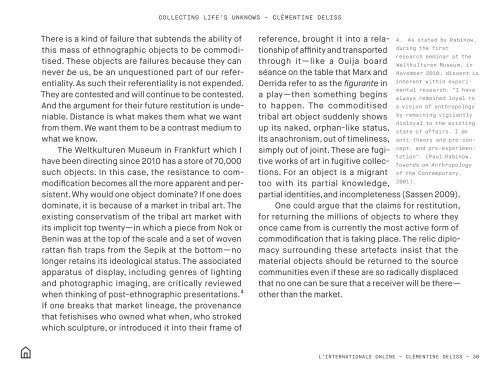DECOLONISING MUSEUMS
decolonisingmuseums-4
decolonisingmuseums-4
Create successful ePaper yourself
Turn your PDF publications into a flip-book with our unique Google optimized e-Paper software.
COLLECTING LIFE’S UNKNOWS – CLÉMENTINE DELISS<br />
There is a kind of failure that subtends the ability of<br />
this mass of ethnographic objects to be commoditised.<br />
These objects are failures because they can<br />
never be us, be an unquestioned part of our referentiality.<br />
As such their referentiality is not expended.<br />
They are contested and will continue to be contested.<br />
And the argument for their future restitution is undeniable.<br />
Distance is what makes them what we want<br />
from them. We want them to be a contrast medium to<br />
what we know.<br />
The Weltkulturen Museum in Frankfurt which I<br />
have been directing since 2010 has a store of 70,000<br />
such objects. In this case, the resistance to commodification<br />
becomes all the more apparent and persistent.<br />
Why would one object dominate? If one does<br />
dominate, it is because of a market in tribal art. The<br />
existing conservatism of the tribal art market with<br />
its implicit top twenty—in which a piece from Nok or<br />
Benin was at the top of the scale and a set of woven<br />
rattan fish traps from the Sepik at the bottom—no<br />
longer retains its ideological status. The associated<br />
apparatus of display, including genres of lighting<br />
and photographic imaging, are critically reviewed<br />
when thinking of post-ethnographic presentations. 4<br />
If one breaks that market lineage, the provenance<br />
that fetishises who owned what when, who stroked<br />
which sculpture, or introduced it into their frame of<br />
reference, brought it into a relationship<br />
of affinity and transported<br />
during the first<br />
through it—like a Ouija board<br />
séance on the table that Marx and<br />
Derrida refer to as the figurante in<br />
a play—then something begins<br />
to happen. The commoditised<br />
tribal art object suddenly shows<br />
up its naked, orphan-like status,<br />
its anachronism, out of timeliness,<br />
simply out of joint. These are fugitive<br />
works of art in fugitive collections.<br />
For an object is a migrant of the Contemporary,<br />
2001).<br />
too with its partial knowledge,<br />
partial identities, and incompleteness (Sassen 2009).<br />
One could argue that the claims for restitution,<br />
for returning the millions of objects to where they<br />
once came from is currently the most active form of<br />
commodification that is taking place. The relic diplomacy<br />
surrounding these artefacts insist that the<br />
material objects should be returned to the source<br />
communities even if these are so radically displaced<br />
that no one can be sure that a receiver will be there—<br />
other than the market.<br />
4. As stated by Rabinow,<br />
research seminar at the<br />
Weltkulturen Museum, in<br />
November 2010, dissent is<br />
inherent within experimental<br />
research: “I have<br />
always remained loyal to<br />
a vision of anthropology<br />
by remaining vigilantly<br />
disloyal to the existing<br />
state of affairs. I am<br />
anti-theory and pro-concept,<br />
and pro-experimentation”.<br />
(Paul Rabinow,<br />
Towards an Anthropology<br />
L’INTERNATIONALE ONLINE – CLÉMENTINE DELISS – 30


